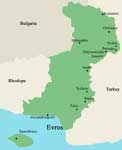.
Administrative Region : East Macedonia and Thrace
Regional unit : Evros
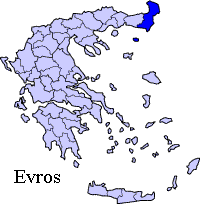
|

Municipality Didymoteicho |
Didymoteicho (Greek: Διδυμότειχο, [ðiðiˈmotixo]) is a town located in the eastern part of the Evros peripheral unit of Thrace, Greece. It is the seat of the municipality of the same name. The town (pop. 8,799 in 2001) sits on a plain and located south east of Svilengrad, south of Edirne, Turkey and Orestiada, west of Uzunköprü, about 20 km north of Soufli and about 90 km north of Alexandroupoli. The municipality of Didymóteicho has a land area of 569.5 km² and a population of 23,484 inhabitants.

A church in Didymoteicho [Source]
Name
The city was formerly known in Katharevousa as Διδυμότειχον, Didymóteichon, from δίδυμος, dídymos, "twin" and τεῖχος, teîchos, "wall". Other names of Didymoteicho include:
Bulgarian: Димотика Dimotika
Turkish: Dimetoka
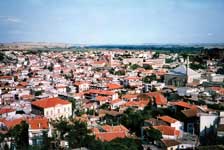
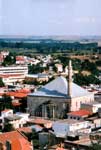
Didymoteicho, Bayezid (Mehmed I) Mosque,
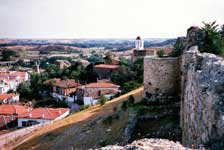
Geography
Forests dominate the banks and parts of the plain. Much of the area is used for farming. The main produce is cattle, fruits and vegetables and some flowers. The hills dominate further west. Near the area lies the great forest of Dadia. Didymoteicho is located around 12 km from Turkey and the western banks of the Evros. It is the easternmost municipality on the mainland of Greece (in its town of Pythio). In the west, much of the land is mountainous and forested, while farmlands are located in the central and the northern part. It is on the railway line Thessaloniki-Istanbul and the Greek road 51 (Alexandroupoli - Orestiada - Edirne in Turkey and Svilengrad in Bulgaria).
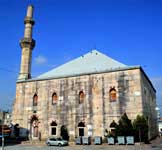
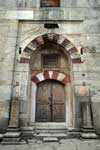
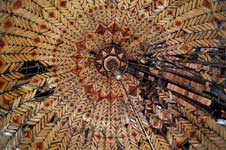
Bayezid (Mehmed I) Mosque, Bayezid Mosque, Bayezid Mosque,
Municipality
The municipality Didymoteicho was formed at the 2011 local government reform by the merger of the following 2 former municipalities, that became municipal units:[1]
Didymoteicho
Metaxades
The largest settlements, other than Didymoteicho itself, are Lagós (pop. 1,403), Koufóvouno (958), Sofikó (926), Ellinochóri (756), and Karotí (723).
History
Ancient times
The area around the town was founded at neolithic times. It was an important Thracian and Hellenistic town. The town was sacked by the Romans in 204 BC. In the early 2nd century, the Roman emperor Trajan created a new city between the two hills surrounding the town and named it Plotinopolis after his wife Pompeia Plotina. The city would later be one of the most important town in Thrace, having her own assembly. Its remains are now known as the Kale, after the Turkish for "castle". In the 1980s, a solid gold bust of Trajan was found on the site of Plotinopoulis and is now in the museum at Komotini.
Medieval era
In medieval times, known as Demotika, it was an important market town and one of the finest hunting places for emperors and later sultans. It was well fortified by the Byzantines and after their reconquest of Constantinople in 1261, it became the most important city in Thrace and Byzantine Macedonia. The city was besieged several times by the Second Bulgarian Empire, and during the Byzantine civil wars of the 14th century, it rose to prominence as the seat of Andronikos III Palaiologos and John VI Kantakouzenos. The city was also the birthplace of emperors John III Vatatzes and John V Palaiologos.[2]
Ottoman era
Further information: Ottoman Greece
The Battle of Demotika, the Ottomans' first victory in Europe, was fought before the city in 1352 during yet another Byzantine civil war. In 1361, and after several years of siege, the Ottomans succeeded in conquering the city. Unlike the neighbouring Adrianople which was burnt to the ground, they kept the town intact and made it the capital of the Ottoman Empire for a short time. It was then that they build the great mosque and the baths of the town, both of which were the first of their kind in the European continent. Under Turkish rule the town was known as Dimetoka or Demotika. The Ottoman sultan Bayezid II was born there. After the Battle of Poltava, the exiled King Charles XII of Sweden lived in the town (1713–1714). During the Ottoman period, it was a major center for the Bektashi Sufi order.
Modern era
In 1912 the town was briefly occupied by the Bulgarians during the First Balkan War, only to return to the Ottomans a year later. The latter offered the city to Bulgaria in 1914, as a reward for entering World War I on the side of the Central Powers. The town was withdrawn from Bulgaria under the terms of the 1919 Treaty of Neuilly.[3] As other places in Western Thrace Didymoteicho was under temporary management of the Entente led by the French General Sharpe. In the second half of April 1920, at the San Remo conference of the prime ministers of the main allies of the Entente powers (except USA), Western Thrace was given to Greece. The Second World War devastated Didymoteicho.
The town was considerably affected by the Evros river flooding of February 17 to 22, 2005. Flood warnings were reported at that time. It devastated much of the town on Wednesday, March 2, 2005 and continued for several days. On Friday, March 4, flood waters began to ebb slowly. Over 5,000 mm of rainfall caused the river to overflow its banks. Buildings, properties and stores were flooded, leaving people stranded. It was the worst flood in nearly 50 years. The railway line south of Didymoteicho and near the station was also flooded and was closed. Serious flooding was also experienced in March 2006 throughout the city and the general Evros area.
Landmarks
A 14th-century mosque, situated by the city square. It was built in 1395 or 1397 under Sultan Bayezid I.
Castle, situated in the northwestern part of town
Didymoteicho Folklore Museum
The 'Silent Baths', the oldest hamam in Europe. They are still in use today.
International Centre of Young Artists of Eastern Europe, Website
Central Square , next to the town hall
Military Museum, [1], (English) (Greek)
Municipal Theatre, on Georgios Street
The ruins of the ancient city of Plotinopolis.
The Byzantine town wall and it's fortifications, situated around the town.
Bayzeid - Mehmed I Mosque - 14th-century
The construction of the Mosque Bayzeid (Mehmed I) was commissioned by the Sultan Mehmed, son of Bayzeid and it was inaugurated in March 1420. The Mosque nowadays is ruined but a maintenance - renovation project is running by the Greek Ministry of culture.
Historical population
Year Population
1991 19,450
2001 18,998
Notable people
John III Doukas Vatatzes (c. 1192-1254), emperor of Nicaea
John V Palaiologos (1332–1391), Byzantine Emperor
Bayezid II(1481–1512) Sultan of the Ottoman Empire
Eugenios Eugenidis (1882–1954), shipping magnate
Silahdar Seyyid Mehmed Pasha 18th century Ottoman Grand Vizier
See also
Communities of the Evros prefecture
References
^ Kallikratis law Greece Ministry of Interior (Greek)
^ http://www.thrakiki.gr/didimotixo.htm
^ Treaty of Neuilly, article 27 (3), 48
| Municipal unit Didymoteicho |
|---|
| Municipal Community Didymoteicho |
| Didymoteicho (Διδυμότειχο, το) |
| Neoi Psathades (Νέοι Ψαθάδες, οι) |
| Municipal Community Ellinochori |
| Ellinochori (Ελληνοχώρι, το) |
| Thyrea (Θυρέα, η) |
| Lagos (Λαγός, ο) |
| Community Asvestades |
| Asvestades (Ασβεστάδες, οι) |
| Community Asimenio |
| Asimenio (Ασημένιο, το) |
| Community Isaakio |
| Isaakio (Ισαάκιο, το) |
| Community Karoti |
| Karoti (Καρωτή, η) |
| Community Koufovouno |
| Koufovouno (Κουφόβουνο, το) |
| Community Kyani |
| Kyani (Κυανή, η) |
| Community Mani |
| Evgeniko (Ευγενικόν, το) |
| Mani (Μάνη, η) |
| Sitaria (Σιταριά, η) |
| Community Petrades |
| Petrades (Πετράδες, οι) |
| Community Poimeniko |
| Poimeniko (Ποιμενικόν, το) |
| Community Prangi |
| Πραγγίο, το |
| Community Pythio |
| Pythio (Πύθιο, το) |
| Rigio (Ρήγιο, το) |
| Σταθμός, ο |
| Community Sitochori |
| Sitochori (Σιτοχώρι, το) |
| Community Sofiko |
| Sofiko (Σοφικόν, το) |
| Municipal unit Metaxades |
Greece :
A - B - C - D - E - F - G - H - I - J - K - L - M -
N - O - P - Q - R - S - T - U - V - W - X - Y - Z
| Ancient Greece
Science, Technology , Medicine , Warfare, , Biographies , Life , Cities/Places/Maps , Arts , Literature , Philosophy ,Olympics, Mythology , History , Images Medieval Greece / Byzantine Empire Science, Technology, Arts, , Warfare , Literature, Biographies, Icons, History Modern Greece Cities, Islands, Regions, Fauna/Flora ,Biographies , History , Warfare, Science/Technology, Literature, Music , Arts , Film/Actors , Sport , Fashion --- |
Retrieved from "http://en.wikipedia.org/"
All text is available under the terms of the GNU Free Documentation License


